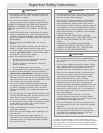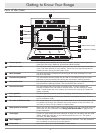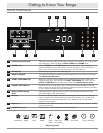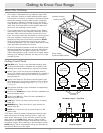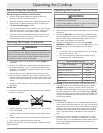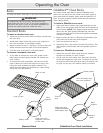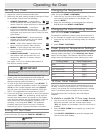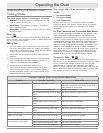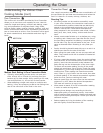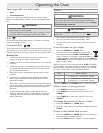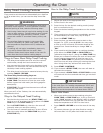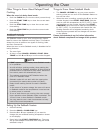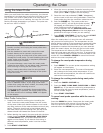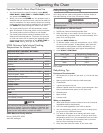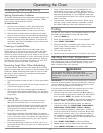
11
Operating the Oven
Your range offers three convection cooking
modes:
• Convection Bake
• Convection Roast
• Pure Convection
As a general rule, in the convection modes, the cook-
ing time is about 25% shorter. Set the timer 15 minutes
before the shortest stated time and add more time if
necessary.
For Pure Convection and Convection Bake Modes:
Some recipes, especially those that are homemade, may
require adjustment and testing when converting from
standard to convection baking. If you are unsure how to
convert a recipe, begin by preparing the recipe using the
standard bake settings. After achieving acceptable results
in standard bake mode, adjust the convection cooking
times according to the guidelines above. If the food is not
cooked to your satisfaction during this first convection
trial, adjust one recipe variable at a time (such as cooking
time, rack position, or temperature) and repeat the con-
vection test. If necessary, continue adjusting one recipe
variable at a time until you get satisfactory results.
Convection Bake
Use this mode for single rack baking. The combination of
the convection fan and bottom heat source is best for fruit
crisps, custard pies, double-crusted fruit pies, quiches,
yeast breads in a loaf pan and popovers. Also, items
baked in a deep ceramic dish or earthenware clay pots are
best in this mode. Most of these items cook in a deep pan
and require browning on the top and bottom.
Understanding the Various Oven
Cooking Modes
The three basic styles of cooking in an oven:
• BAKING - The gentle cooking of dry goods such as
cookies, cakes, soufflés, etc.
• ROASTING - The cooking of meats or vegetables
over a period of time.
• BROILING - Cooking with an intense heat for a short
amount of time.
Bake
Uses only a heat source from below the food. This mode
is the stand-by, non-convection mode. All baked items will
turn out nicely in this mode.
Baking Tips
• For best results, use a single rack in the lowest posi-
tion when using bake mode. For cooking on multiple
racks, Dacor recommends using one of the convection
modes. See the following pages.
• Follow your recipe’s original cooking time and tem-
perature.
• Do not open the oven door frequently during baking.
Look through the oven door window to check the
progress of baking whenever possible.
• Use the timers to determine baking time.
• Wait until the shortest recommended baking time
before checking the food. For most baked goods, a
wooden toothpick placed in the center should come
clean when the food is done.
Common Problems When Using Standard Bake Mode
Problem May Be Caused By What to Do
Cookies burn on the bottom. Oven door opened too often. Set timer to shortest recommended cooking
time and check food when timer beeps. Use
door window to check food.
Incorrect rack position used. Change rack position.
Dark, heat absorbing cookie sheets
used.
Use shiny, reflective cookie sheets.
Cookies are too brown on top. Rack position being used is too
high.
Change rack position.
Food placed in oven during pre-
heat.
Wait until oven is preheated.
Cakes burn on the sides or are
not done in the center.
Oven temperature too high. Reduce oven temperature.
Dark, heat absorbing cake pans
used.
Use shiny, reflective cake pans.
Cakes crack on top. Oven temperature too high. Reduce oven temperature.
Cakes are not level. Oven and/or oven rack not level. Level oven and rack as needed.
Pies burn around the edges or
are not done in the center.
Oven temperature too high. Reduce oven temperature.
Dark, heat absorbing pans used. Use shiny, reflective pans.
Oven and/or rack over-crowded. Reduce number of pans.
1 2
1 2
1 2



